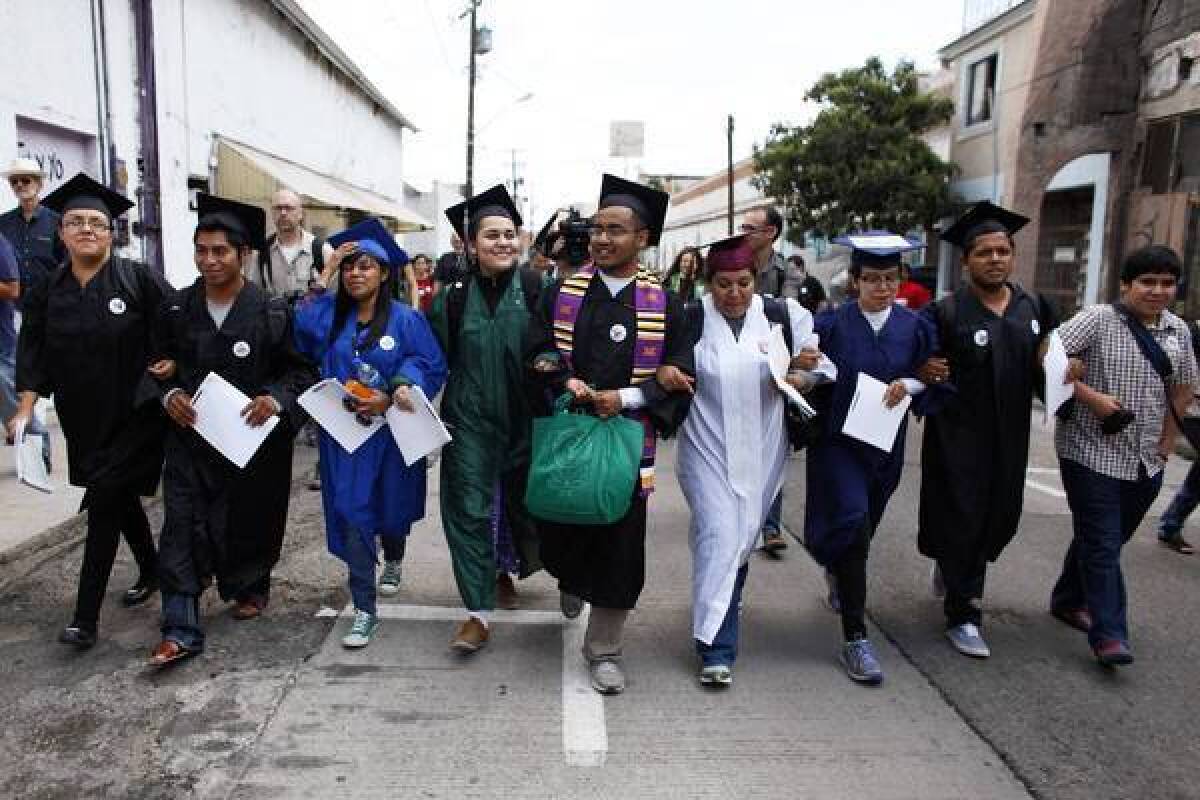Immigrant rights activists at odds over ‘Dream 9’

TUCSON — When a group of young immigrant rights activists devised a plan last month to stage an unconventional protest at the U.S.-Mexico border to draw attention to the thousands deported under the Obama administration’s immigration policy, Lizbeth Mateo was a little afraid that onlookers would react negatively.
The protest, after all, could have meant their deportation.
Then the letters poured in. Hundreds of them. All positive and addressed to Mateo, 29, and other protesters who, as a result of their daring demonstration, were stopped, handcuffed and taken to an immigration detention facility in south-central Arizona.
“You are crazy but we support you,” one person wrote to her.
Even an official at the law school where she was accepted wrote to Mateo while she was in detention, promising to hold a spot for the student born in Mexico but raised in Los Angeles.
But outside the walls of the Eloy Detention Center, a debate began to brew about the political implications of the actions taken by the “Dream 9,” as they have been called — five women and four men brought to the United States illegally as children.
On July 22, the group — all Mexican nationals but American in almost every other way except legally — demanded to enter the United States at a Nogales, Ariz., port of entry under the glare of international media.
The move not only forced the Obama administration into an awkward position, it did the same to some activists who have been working for years to pass immigration reform for the estimated 11 million who are living in this country illegally. Some activists praised the protest, but it also drew controversial comments from some of the immigrant rights movement’s staunchest supporters.
The protest took root last month when Mateo, Marco Saavedra of New York and Lulu Martinez of Chicago voluntarily crossed the border into Mexico in protest of the administration’s deportation policies. They tried to reenter the U.S. with six others who also had been brought to this country illegally as children, but who had returned to Mexico more than a year ago for various reasons.
The nine have said they had no idea what to expect. There was a chance they would have been denied entry and left in Mexico. Instead, they were taken into custody on the U.S. side of the border.
They became the Dream 9, a name that comes from the Dream Act, which would provide a path to legalization for young people who were brought into the country illegally as children.
Immigration officials decided that all nine could move forward in their bids for asylum, and released them Wednesday on parole to their American communities until their day in immigration court — a process likely to take years.
However, the immigrant rights movement is still abuzz on whether the group’s actions will have a lasting impact.
Perhaps the most vocal critic is Dave Leopold, former national president of the American Immigration Lawyers Assn., who practices immigration law in Cleveland.
Leopold said that he respected the Dream 9 and their commitment, but that the group’s strategy was misguided. He contends that there will be no positive effect on the overall movement.
Instead, he said, the group should have pressured the House of Representatives, specifically House Speaker John A. Boehner (R-Ohio), to move forward on immigration reform, which sits stagnant.
“I know I’ve taken a lot of heat. But I’m just the messenger. I’m just saying what a lot of people are thinking,” said Leopold, who got blasted by some immigrant rights organizers after he spoke out about the group’s tactics.
“I’m standing back and saying, ‘Wait a minute, what is it that you are trying to show? What great point was made out of this?’” he said. “We already know the immigration system is broken. In a year from now, are we even going to remember this?”
Jorge-Mario Cabrera, spokesman for the Coalition for Humane Immigrant Rights of Los Angeles, disagrees.
“This will be one of those actions that will be remembered,” he said.
He said that although the organization didn’t support the group’s actions — concerned that the activists went too far by putting themselves at risk of deportation and detention — their plight had advanced the immigration reform movement. Cabrera said it put a human face to immigration policy that has led to the deportation of thousands under the Obama administration.
“The message behind their actions is being heard loud and clear in this summer of expectations,” he said.
Organizers with the National Immigrant Youth Alliance who orchestrated the Nogales protest have said that the point was to draw attention to the mass deportations under the Obama administration and call for a more humane immigration policy.
However, Leopold worried that the Dream 9 could inspire other Mexicans to do the same, but without the same legal representation, preparation and media attention.
The group didn’t simply walk up to the border and demand immigration relief. Advance publicity meant they were followed to the port of entry by a horde of U.S. and Mexican journalists — and they came with their own attorney and voluminous legal documents to make their case.
Not everyone has that luxury, Leopold noted.
“There are serious potential ramifications from someone who is undocumented and leaves the United States, who runs around and comes back,” he said.
Though some in the legal community may see them as novices and reckless, Carlos Spector, an immigration attorney in El Paso who is considered an expert in Mexican asylum claims, said he applauded the Dream 9 and their attorney.
“I thought it was a very well-thought-out and courageous plan,” he said.
Winning asylum will be difficult, said Spector, adding that 98% of asylum claims made by Mexican nationals are denied. Still, if their cases ever get to a judge, they could potentially establish and identify a new social group of people eligible for asylum, easing the way for more Mexicans belonging to that particular group to do the same, he added.
Case law is created by people who think outside the box, Spector said.
“It’s about time that a social movement and people start putting demands on lawyers to break traditional analysis,” Spector said. “We’re taught precedent and that if there is no precedent, we don’t proceed with it. The good attorneys are the ones who are always pushing the envelope. Pushing the envelope is a good thing.”
More to Read
Sign up for Essential California
The most important California stories and recommendations in your inbox every morning.
You may occasionally receive promotional content from the Los Angeles Times.











